Related Research Articles
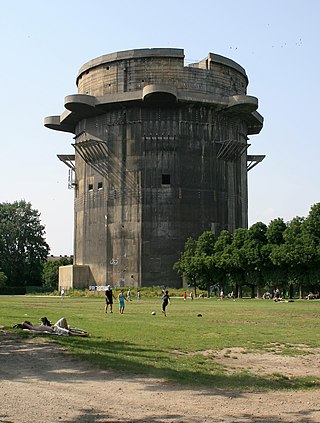
A bunker is a defensive military fortification designed to protect people and valued materials from falling bombs, artillery, or other attacks. Bunkers are almost always underground, in contrast to blockhouses which are mostly above ground. They were used extensively in World War I, World War II, and the Cold War for weapons facilities, command and control centers, and storage facilities. Bunkers can also be used as protection from tornadoes.

The Siegfried Line, known in German as the Westwall, was a German defensive line built during the late 1930s. Started in 1936, opposite the French Maginot Line, it stretched more than 630 km (390 mi) from Kleve on the border with the Netherlands, along the western border of Nazi Germany, to the town of Weil am Rhein on the border with Switzerland. The line featured more than 18,000 bunkers, tunnels and tank traps.

The Greenbrier is a luxury resort located in the Allegheny Mountains near White Sulphur Springs in Greenbrier County, West Virginia, in the United States.

A blockhouse is a small fortification, usually consisting of one or more rooms with loopholes, allowing its defenders to fire in various directions. It is usually an isolated fort in the form of a single building, serving as a defensive strong point against any enemy that does not possess siege equipment or, in modern times, artillery, air force or cruise missiles. A fortification intended to resist these weapons is more likely to qualify as a fortress or a redoubt, or in modern times, be an underground bunker. However, a blockhouse may also refer to a room within a larger fortification, usually a battery or redoubt.

RAF Uxbridge was a Royal Air Force (RAF) station in Uxbridge, within the London Borough of Hillingdon, occupying a 44.6-hectare (110-acre) site that originally belonged to the Hillingdon House estate. The British Government purchased the estate in 1915, three years before the founding of the RAF. Until the outbreak of the Second World War in 1939, the station was open to the public.

The Miami Biltmore Hotel, commonly called TheBiltmore Hotel or The Biltmore, is a luxury hotel in Coral Gables, Florida. The hotel was designed by Schultze and Weaver and built in 1926 by John McEntee Bowman and George Merrick as part of the Biltmore hotel chain. The hotel's tower is inspired by the Giralda, the medieval tower of the cathedral of Seville.
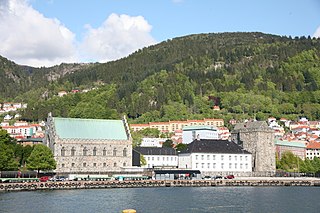
Bergenhus fortress is a fortress located in Bergen, Norway. Located at the entrance of Bergen harbour, the castle is one of the oldest and best preserved stone fortifications in Norway.

Termunten is a village in the Dutch province of Groningen. It is a part of the municipality of Eemsdelta, and lies about 33 km east of Groningen.

Fjell Fortress is located on the island of Sotra in the former municipality of Fjell in Vestland county, Norway.

The Aalborg Defence and Garrison Museum is a military museum in Aalborg, Denmark that covers all branches of Danish defence organizations.

The German 28 cm SK C/34 naval gun was a 283 mm 54.5-caliber built-up gun designed in 1934 used on the Scharnhorst-class battleships.

The Fort Hommet 10.5 cm coastal defence gun casemate bunker is a fully restored gun casemate that was part of Fortress Guernsey constructed by the forces of Nazi Germany between 1940 and 1945.
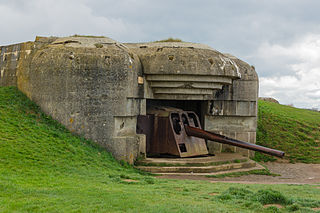
The Longues-sur-Mer battery is a World War II German coastal artillery battery approximately 1 km (0.62 mi) north of the village of Longues-sur-Mer in Normandy, France. The battery is sited on a 60 m (200 ft) cliff overlooking the Baie de Seine and formed a part of Germany's Atlantic Wall coastal fortifications, between the Allied landing sectors of Gold Beach and Omaha Beach.

Battery Lothringen was a World War II coastal artillery battery in Saint Brélade, Jersey, named after the SMS Lothringen, and constructed by Organisation Todt for the Wehrmacht during the Occupation of the Channel Islands. The first installations were completed in 1941, around the same time as the completion of the nearby Battery Moltke, in St. Ouen.

Austrått Fort is a disused coastal artillery site located at Austrått in Ørland, Norway. It was constructed in 1942 by the German Wehrmacht to protect the Trondheimsfjord during the German occupation of Norway during World War II. The fort's centrepiece is a triple 28 cm SK C/34 (11-inch) gun turret from the German battleship Gneisenau, which was damaged in Kiel. The three-gun turret weighs 800 tons and was capable of firing 730-pound shells 38 kilometres (24 mi). The last firing took place in 1953 and the fort was decommissioned in 1968. It opened as a museum in 1991.
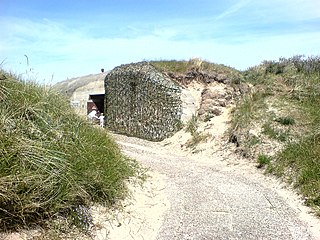
Skagen Bunker Museum is a private museum near the tip of Grenen in the far north of Jutland, Denmark. It is located in an old German bunker of the Regelbau 638 type which was used during the Second World War as an infirmary for treating wounded soldiers. It is now fitted out as a small museum with uniforms, weapons and other artifacts.

The Regelbau were a series of standardised bunker designs built in large numbers by the Germans in the Siegfried Line and the Atlantic Wall as part of their defensive fortifications prior to and during the Second World War.
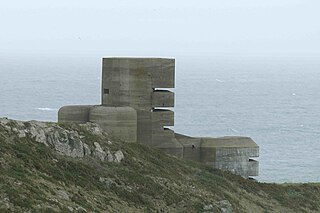
After the Wehrmacht occupied the Channel Islands on 30 June 1940, they assessed the existing defences to determine if they would be of use. The Germans found the Islands' fortifications antiquated and woefully inadequate for modern warfare.
Amfreville battery was a World War II German artillery battery constructed close to the French village of Querqueville, 5 km (3.1 mi) west of Cherbourg Naval Base, in northwestern France. It formed part of Germany's Atlantic Wall coastal fortifications and protected the western entrance to the port of Cherbourg. The battery engaged British and US ships towards the end of June 1944 before the battery fell to advancing US forces on 26 June 1944.
References
- ↑ "Typology". Belgian Bunkersite. Archived from the original on 6 July 2011. Retrieved 12 October 2010.
- ↑ "Fjell Festning Militærhistoriske Samlinger: Regelbau 638". Fjell Festning Militærhistoriske Samlinger. Blogger. 20 September 2009. Retrieved 12 October 2010.